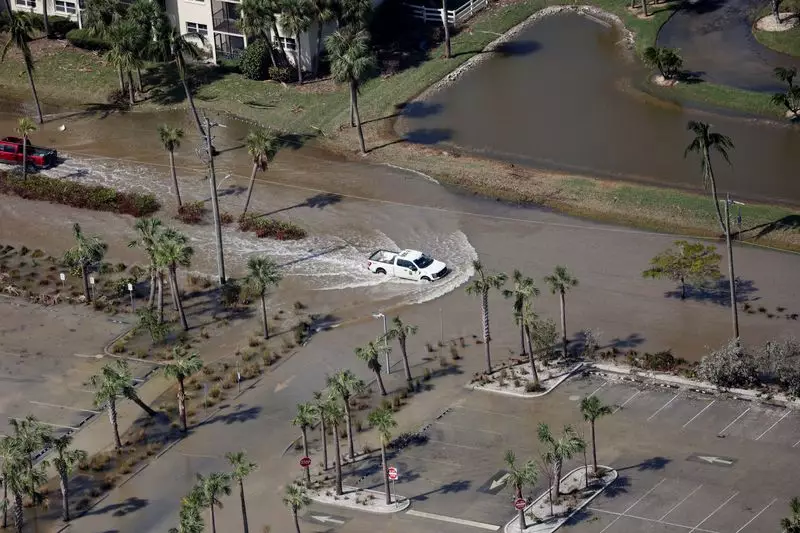Hurricane Milton, a powerful Category 3 storm, made landfall on Florida’s west coast late Wednesday, unleashing winds of up to 120 mph and causing devastation across the state. As the storm barreled through Florida’s landscape, it left a trail of destruction that included the loss of life and widespread power outages, affecting millions. Although the anticipated storm surge failed to materialize at critical points, the destruction wrought by tornadic activity painted a grim picture of the hurricane’s true capabilities, leaving residents in shock and communities grappling with the aftermath.
Governor Ron DeSantis was quick to stress that Florida had escaped the “worst-case scenario,” an acknowledgment that, while almost relieved, serves as a stark reminder of the threats posed by hurricanes. Despite the absence of a catastrophic surge, the reality of the situation was dire, as severe flooding plagued coastal areas, particularly the barrier islands south of Tampa Bay. This dilapidated landscape, coupled with the sheer number of tornadoes reported, showcased the myriad dangers that hurricanes pose beyond just strong winds and rising tides.
In total, 27 tornadoes were recorded across Florida as Milton passed through, highlighting a disturbing and often overlooked aspect of hurricane dynamics. Among the most devastating incidents were those in St. Lucie County, where five lives were tragically lost, predominantly affecting vulnerable populations in senior living facilities. Eyewitness accounts from residents illuminated the chaotic atmosphere, such as that of Crystal Coleman, who described seeking shelter in her bathroom while her home began to disintegrate around her. The chaos of the storm, punctuated by sound and fury, has become a haunting memory for many Floridians.
The disparity between the expected storm surge and actual events brings attention to the complex nature of meteorological phenomena. While the region remained largely spared from flooding caused by seawater, the inland ramifications of the storm were catastrophic. Tornadoes became the forefront of the destruction narrative, showcasing how hurricanes can unleash chaos far removed from the coastlines.
As day broke on Thursday, the human cost of Hurricane Milton became increasingly evident. Reports indicated that over 3.2 million residents and businesses across Florida found themselves without electricity, with many still recovering from power disruptions caused by Hurricane Helene just two weeks prior. This double assault on infrastructure poses a detrimental drain on resources, while complicating recovery efforts as communities strive to regain normalcy amid pervasive power outages.
In St. Petersburg, the local baseball stadium, Tropicana Field, evolved into a refuge for those affected by the storm, transitioning into an emergency response center as thousands sought shelter from the disarray outside. The damage was widespread, as seen in the collapsed crane that dramatically split a building in downtown St. Petersburg.
These anecdotes, reflective of personal experiences during the storm, underscore the unpredictability of severe weather and its tangible impacts on everyday life. For residents like Steven Cole Smith, who chose to ride out the storm rather than evacuate, the jolting winds and battered windows forged a survivor’s tale amidst the chaos. In contrast, those who did heed evacuation warnings, like Ken Wood, spoke of the difficult choices surrounding flight and safety in the face of unpredictable weather events.
The destruction caused by Hurricane Milton extends beyond immediate damages. As communities grapple with recovery, the potential for subsequent flooding remains a pressing concern. Up to 18 inches of rain fell in some areas, raising fears of river flooding as authorities monitor water levels. The initial assessment of damage from the Federal Emergency Management Agency (FEMA) highlights the importance of preparedness and robust disaster relief systems, which easily become overwhelmed during such widespread emergencies.
Amid these tribulations, President Joe Biden’s call for Congress to reconvene focused on disaster relief funding underscores the critical nature of governmental support in times of crisis. Yet, the political landscape introduces additional complexities as lawmakers balance urgent needs against their schedules.
In hindsight, Hurricane Milton stands as a stark reminder of nature’s unpredictability and the resilience of communities to navigate the ensuing challenges. As recovery efforts ramp up, it is essential to address the underlying vulnerabilities exposed by such storms, ensuring that lessons learned translate into better preparedness for future hurricanes and severe weather events. The journey to recovery may be long, but with each effort to rebuild, Floridians will find strength amid the debris, striving for a brighter, more secure tomorrow.

